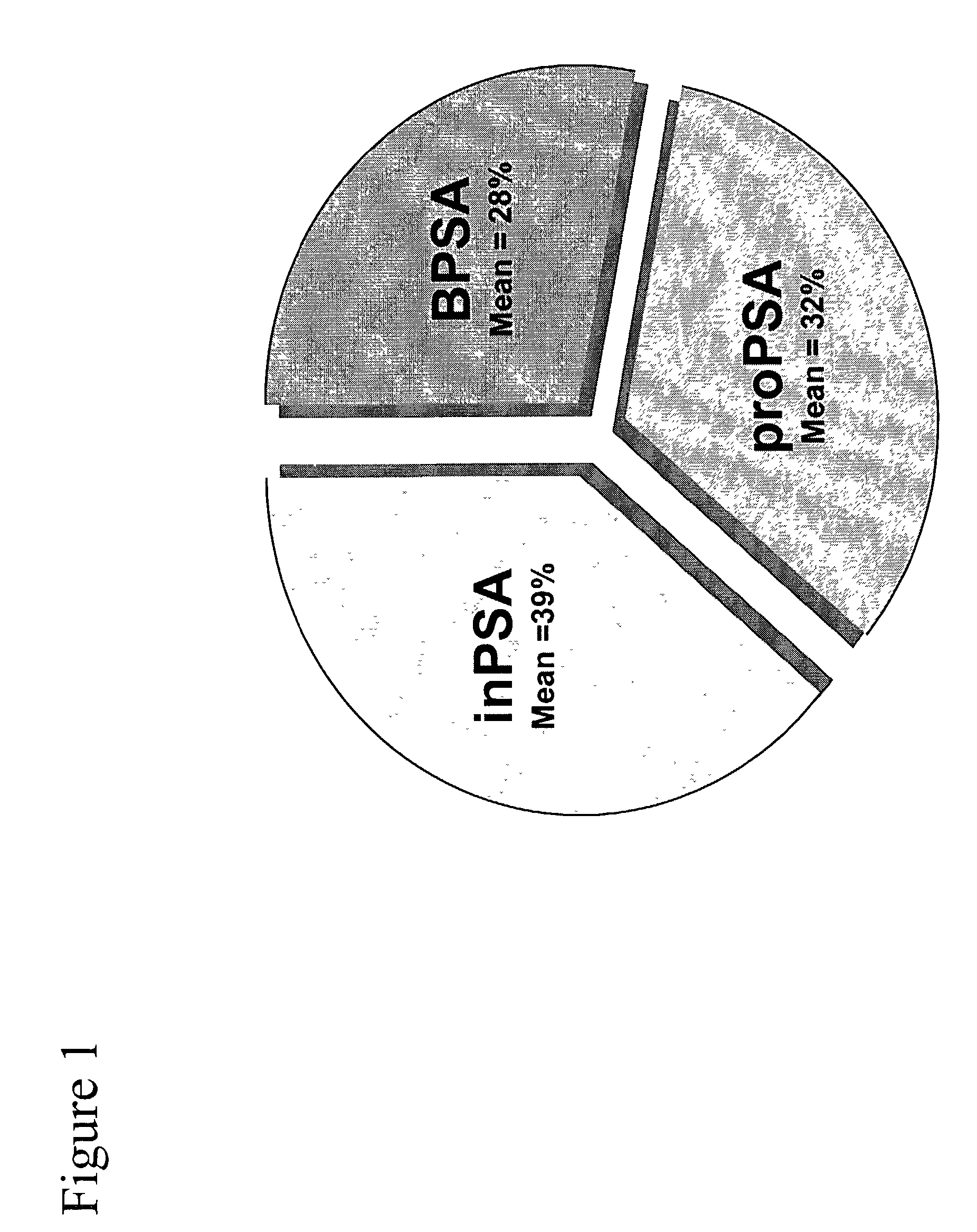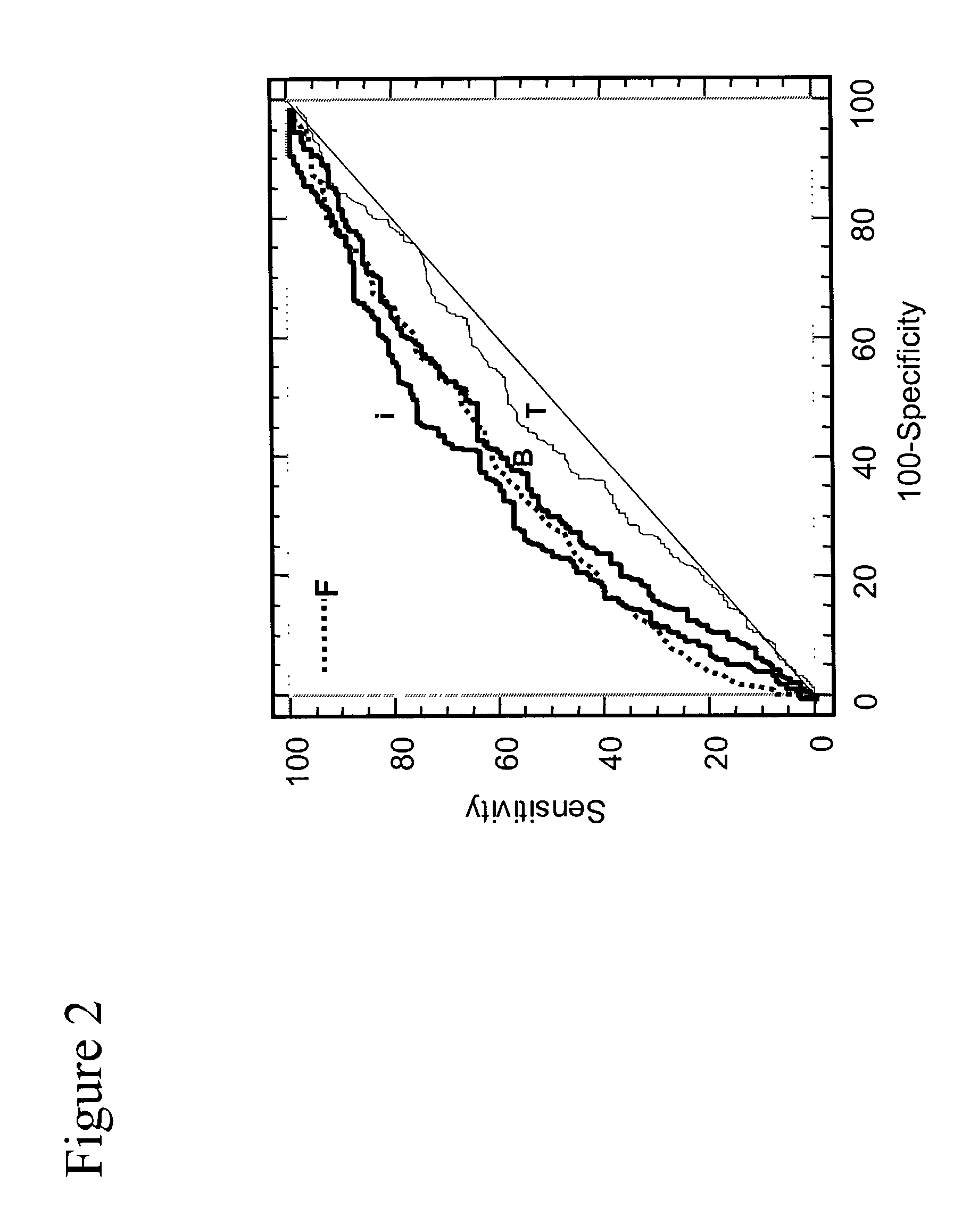Method of analyzing non-complexed forms of prostate specific antigen in a sample to improve prostate cancer detection
a prostate specific antigen and sample technology, applied in the field of detection and identification of proteins, can solve the problem of not well-defined psa measurement natur
- Summary
- Abstract
- Description
- Claims
- Application Information
AI Technical Summary
Benefits of technology
Problems solved by technology
Method used
Image
Examples
example i
Analysis of Serum of Men with Cancer and Benign Disease Containing Total PSA Between 4 and 10 ng / ml
Materials and Methods
Development of Monoclonal Antibodies (mAbs) to BPSA and pPSA
[0063]Monoclonal antibodies to [−2]pPSA, [−4]pPSA, [−5,−7]pPSA, and BPSA have been previously described[12–16]. The [−7]pPSA mAb also recognizes the [−5]pPSA form of pPSA. For the purposes of these examples, wherever the term [−7]pPSA is written , both [−5] plus [−7]pPSA is indicated. The term pPSA indicates [−2] plus [−4] plus [−5] plus [−7]pPSA.
Immunoassay of PSA
[0064]The concentration of PSA in serum and purified preparations was determined by Tandem®-MP PSA and Tandem®-MP free PSA assays (Hybritech Incorporated, San Diego, Calif.; Beckman Coulter, Inc., Fullerton, Calif.).
Immunoassay of [−2], [−4] and [−5,−7] pPSA
[0065]The immunoassay we have developed for the measurement of the pPSA forms is as follows. 50 ul of biotinylated anti-PSA Ab PSM 773 at 5 ug / ml in Tandem® PSA zero cal diluent is added to a ...
example ii
Analysis of Serum of Men with Cancer and Benign Disease Containing Total PSA Between 2.5 and 4 ng / ml
[0074]As in Example I, the same series of PSA assays were measured in this cohort of patients who have total PSA values from 2.5–4 ng / ml. The range from 2.5–4 ng / ml is an area where many cancers are present but at a lower occurrence than in the 4–10 ng / ml patients in random screening populations. Total PSA does not discriminate cancer in this range, and current attempts to use % F to improve cancer detection in this range have not shown diagnostic value.
[0075]FIGS. 10 and 11 show that inPSA in the range from 2.5–4 ng / ml is a much better predictor of prostate cancer than free forms of PSA. In FIG. 10, inPSA / pPSA and inPSA minus pPSA give similar AUCs which give a positive discrimination of cancer, whereas F / T give virtually no discrimination of cancer. In FIG. 11, inPSA / [−2]pPSA also gives a positive cancer discrimination whereas free PSA gives little or no cancer discrimination.
[0076]...
example iii
Analysis of Serum of Men with Cancer and Benign Disease Containing Total PSA Between 2.5 and 10 ng / ml
[0077]The current PSA range for the early detection of prostate cancer is 4–10 ng / ml. It is recommended that men with PSA in this range receive a biopsy to determine if cancer is present. There is discussion in the clinical literature whether to lower the PSA cutoff below 4 ng / ml, possibly to 2.5 ng / ml. In such a case the current diagnostic PSA and free PSA would be used to recommend biopsy unless other improved tests were available.
[0078]FIGS. 12 and 13 inPSA can be used to improve cancer detection over current assays throughout the whole range of 2.5 to 10 ng / ml. In FIG. 12 inPSA / pPSA improves cancer detection over F / T PSA. In FIG. 13 inPSA minus pPSA give an even better improvement compared to F / T PSA. Since F / T PSA is the best PSA diagnostic marker in use today, this indicates that inPSA has significant potential for cancer discrimination.
PUM
| Property | Measurement | Unit |
|---|---|---|
| concentrations | aaaaa | aaaaa |
| molecular mass | aaaaa | aaaaa |
| concentration | aaaaa | aaaaa |
Abstract
Description
Claims
Application Information
 Login to View More
Login to View More - R&D
- Intellectual Property
- Life Sciences
- Materials
- Tech Scout
- Unparalleled Data Quality
- Higher Quality Content
- 60% Fewer Hallucinations
Browse by: Latest US Patents, China's latest patents, Technical Efficacy Thesaurus, Application Domain, Technology Topic, Popular Technical Reports.
© 2025 PatSnap. All rights reserved.Legal|Privacy policy|Modern Slavery Act Transparency Statement|Sitemap|About US| Contact US: help@patsnap.com



